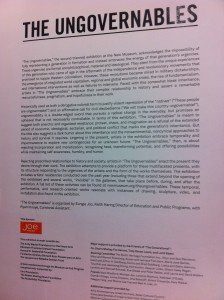Recently the activist group, Liberate Tate, in protest against the Tate Museum’s partnership with British Petroleum, staged an intervention in the classical sculpture galleries by situating a nude, oil-drenched performer directly in the middle of the space for 87 minutes, representing the number of days oil spilled into the Gulf of Mexico two years ago. This provocative image was released of the event:
 Similarly, the group Culture Beyond Oil protested BP’s support of the British Museum by ritualistically pouring out logo-ed casks of oil in front of an Easter Island sculpture in one of their main halls. In this case, the museum actually allows BP to utilize their space for corporate fundraisers and events, making the cooperation even more explicit than in the former example.
Similarly, the group Culture Beyond Oil protested BP’s support of the British Museum by ritualistically pouring out logo-ed casks of oil in front of an Easter Island sculpture in one of their main halls. In this case, the museum actually allows BP to utilize their space for corporate fundraisers and events, making the cooperation even more explicit than in the former example.
In describing their concern, a Liberate Tate contributor said to artdaily.org, “Oil sponsorship of public institutions is a problem that stretches way beyond BP and the catastrophe in the Gulf of Mexico. The oil industry has a long history of environmental and human rights abuses, and is currently pulling us closer and closer to a potential catastrophe on a global scale.” They request an end to these relationships in publicly funded museums and for a full disclosure of funding arrangements with private industry.
The problem, of course, is that public funding cannot cover the full cost of running these massive institutions and without private support the public will no longer have access to the range, depth and breadth of programming they offer. All private funding comes with its share of dubious gains but is it not better that these funds be channeled back to the public rather than further expanding those questionable practices?
Group members claim that the benefits derived from the sponsorships expand oil companies’ brands and give them a humanizing cast that dupes the public into forgiving their misdeeds, but perhaps we should frame it more along the lines of sponsorship as penance. In other words, activities are neither forgiven nor forgotten but we can be glad that the moneys are being channeled to good works. Following the disaster, BP and other culpable companies paid millions to support the clean up and even more toward restoration of the ecosystem channeled through humanitarian causes in the gulf region, is their support of those causes deceiving the public? Should we deny them the opportunity to support those good deeds in retribution for the oversight and business practices that caused the spill? To my mind it would make no sense to limit oil support for ecological organizations–can we look at their support of cultural organizations in the same vein?
In America, our great disdain for public funding of the arts means even greater reliance on corporate support and sponsorships. Recently activists, most likely the group Occupy Wall Street, launched a mock web site for the Whitney Biennial that fantasizes a world where the museum breaks with two of its largest supporters, Deutsche Bank and Sotheby’s and announces a closure on May 1st to support the “day without the 99%” initiative. The call for greater attention to the general public is a real and important aspect of museum studies, but I wonder if it corporate sponsorships are really at the heart of that disparity? Most every museum in the Los Angeles County region is supported by companies like Bank of America, Merrill Lynch, Wells Fargo, UBS, Chevron, Barbie, etc. Obviously many of the corporations have their own checkered pasts and questionable practices but unless we as a culture choose to support the arts in a real way (and, really, what are the chances we’re going to voluntarily raise taxes to do that when half of our wonderful local teachers are being laid off?), the arts depend on these donors.
Yes, sponsorships do benefit corporations, they receive tax benefits as well as publicity from their donations, they are often securing free entry for all employees and the opportunity to host events on museum property, VIP invitations and free catalogs, but is that reason enough to turn away the dollars that make a real difference in museum programming? Donations benefit the corporations, but they benefit museums a whole lot more, and, by doing so, they benefit the public. Is it really realistic to punish the public and the institutions in the name of denying those small benefits to companies? This seems like the equivalent of telling my rambunctious kids that if they don’t shape up we’re going to leave this party right now… except that I don’t want to leave and they don’t really give a crap about leaving and so I have just denied myself a pleasant afternoon without punishing them in any real way – I just hate when that happens!
So, now that I have you all thinking that I’m rallying for the big guy, let me just mention a couple things that the Whitney page, and many protestors, have right. On the faux-whitney page the pledge states, “The Museum will also soon increase the representation of artists, art workers, and low- and middle-income patrons on its board.” Holla! That is the kind of move that could bring real change to an institution, let the development department woo corporations, don’t allow that to be the main function of the board! Museums are relying on their boards as major benefactors which results in a huge wealth and industry disparity in board constitution. For example, the LACMA board of trustees consists almost exclusively of multimillionaire (and billionaire) collectors who have built their fortunes in various industrious including entertainment, sports, and mostly private equity, investment, banking or technology. Despite a carefully worded “Conflict of Interest” agreement for board members, the arrangements between the institution and the board are far more complex and intrinsic than the membership and patrons of the museum would ever know. These decision-makers and leaders are completely out of touch with typical visitors and artists. At MOCA, the board is slightly more inclusive with a few (extremely and unusually successful) artists engaged, probably because dues are comparatively reasonable at “only” $75,000 per year with an entry fee of $250,000.
Recently I blogged about the 60 minutes segment about contemporary art, specifically Art Basel Miami, and Jerry Saltz’s response to Morley Safer’s criticisms. As opposed to Saltz, I don’t think the kind of billionaire bargaining that goes on at art fairs is expected, disliked but not concerning… In fact, the world’s art institutions are being run and financed by collectors whose experience with contemporary art is built on fairs such as Art Basel Miami. To me the mission of the museum is belayed by these associations. Yes, a major art institution needs to have fiscal oversight and commitment from board members, but it also needs to consider the other voice, the voice of patronage and the voices of the artists, critics, and historians whose depth of artistic knowledge is far more irreplaceable than armchair philanthropists.































































